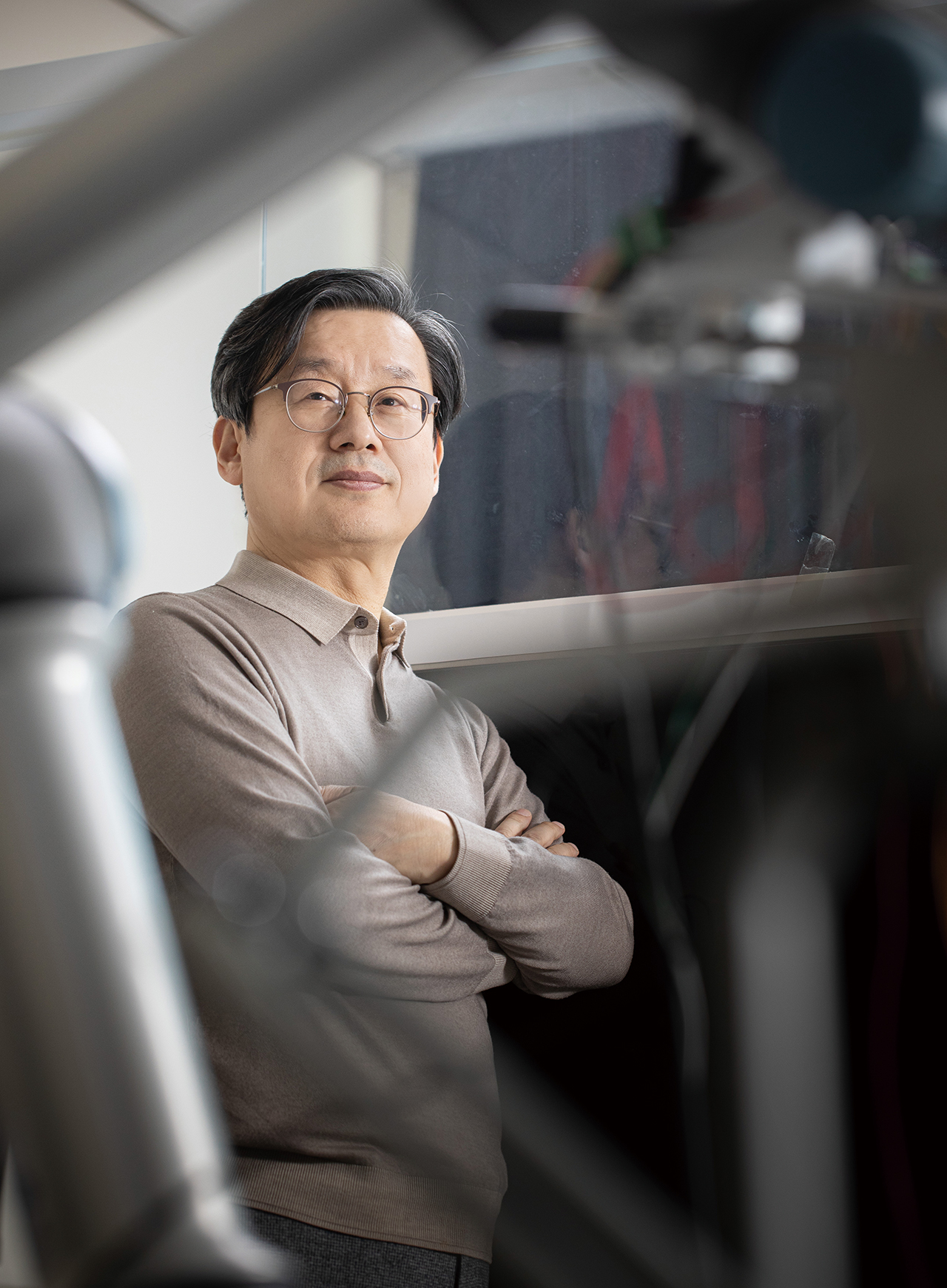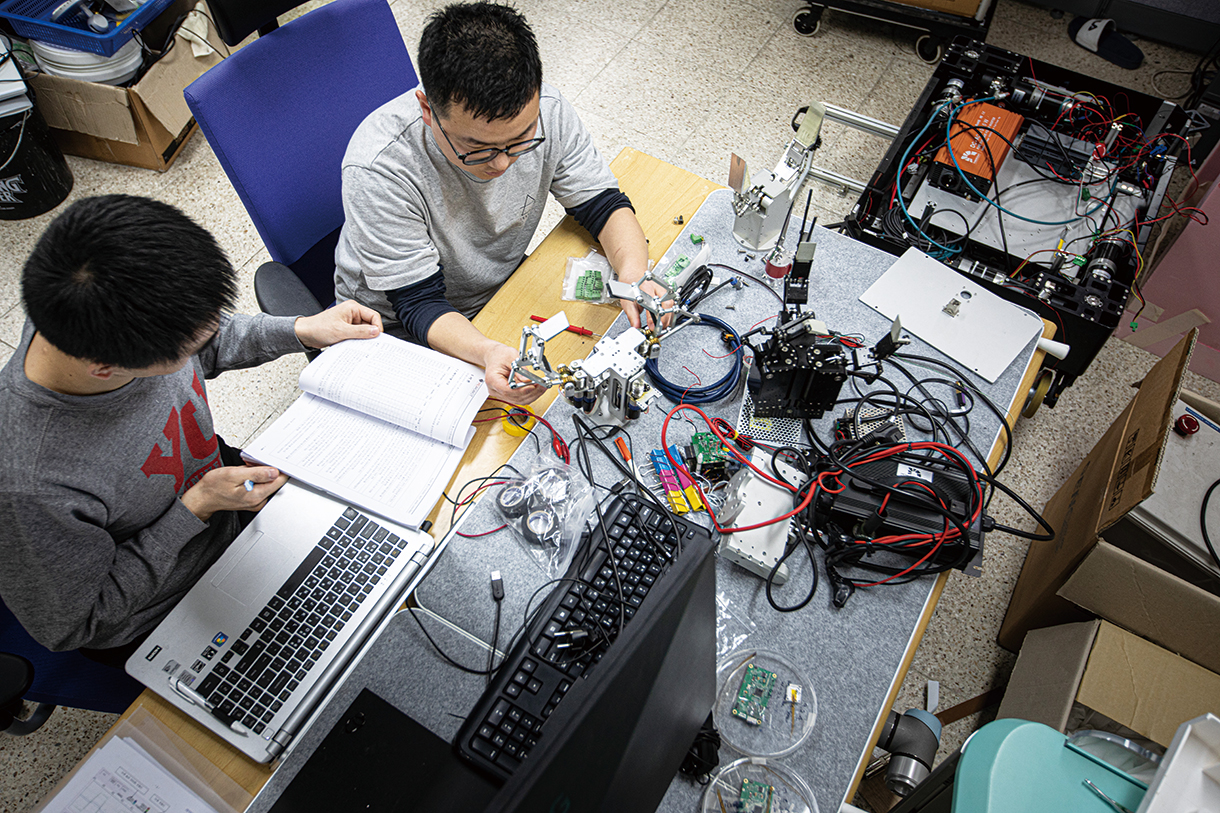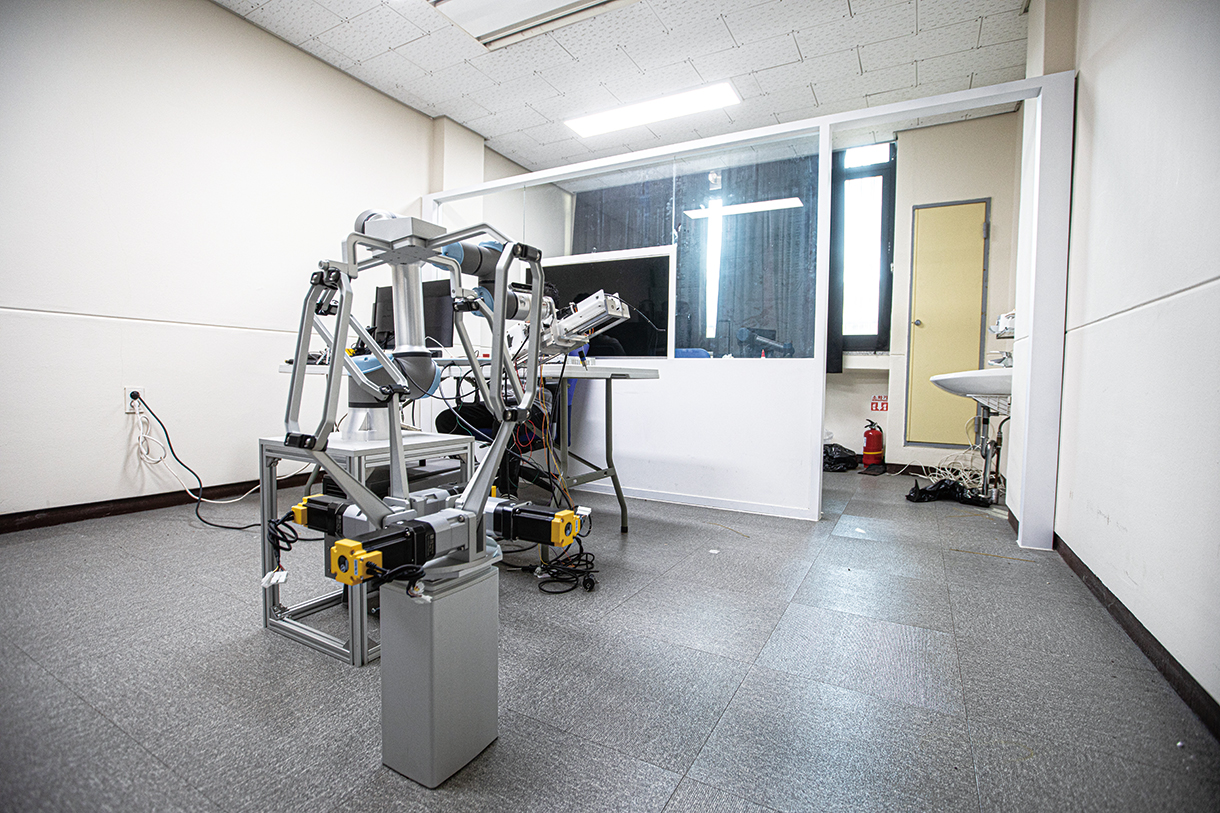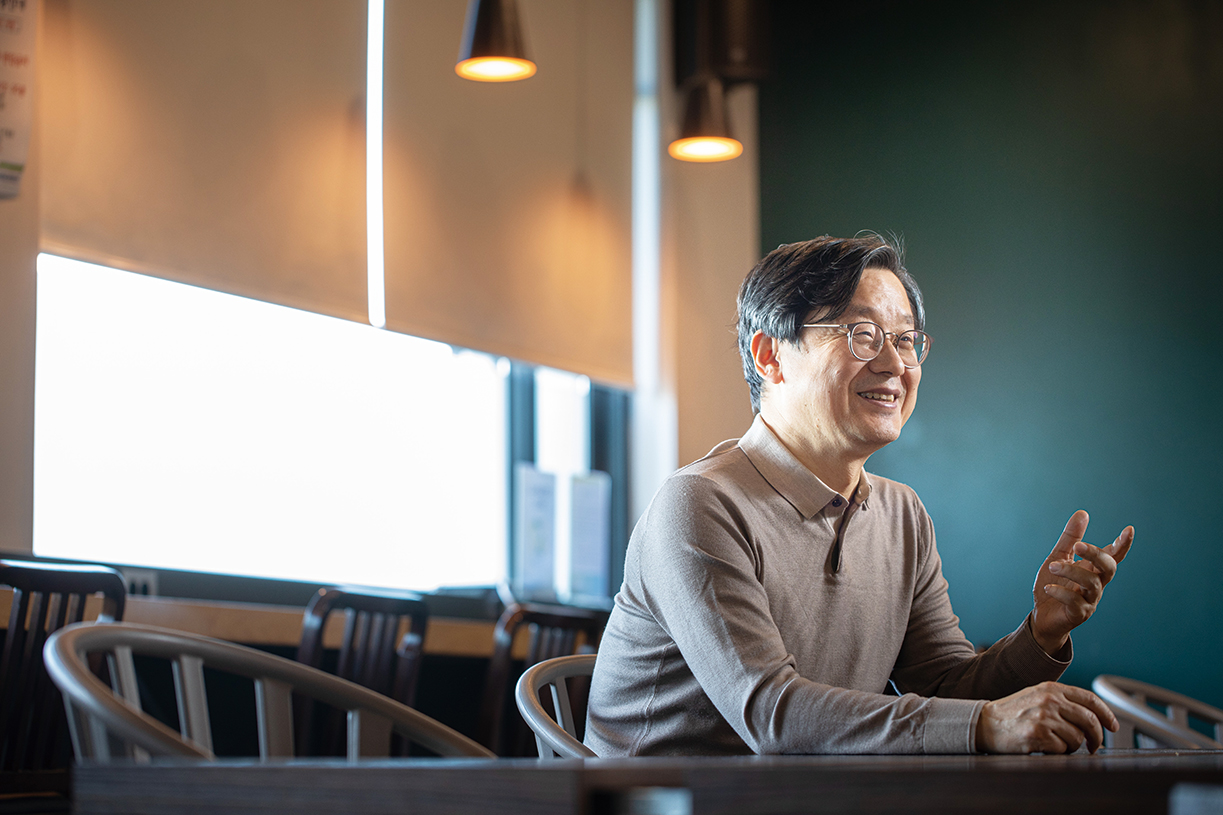

Story
무궁무진한 가능성의 열쇠
미래를 바꿀 로봇산업
The Key to Endless Possibilities
Robot Industry to Change the Future
ERICA캠퍼스 전자공학부 이병주 교수
Prof. Byung-ju Yi, Department of Electronic Engineering at ERICA Campus
- 글 김현지
- 사진 손초원
- Writing Kim Hyun-ji
- Photograph Son Cho-won
Scroll Down
Professor Byung-ju Yi is a first-generation researcher who laid the foundation for robotics in Korea. For a long time, he has served as the president and director of the Korea Robotics Society and the Korean Society of Medical Robotics, observing the development of the industry and relevant technologies. He is also leaving a big mark in the field of medical robotics. We met with Professor Byung-ju Yi, who has been looking at the robot industry from a broader perspective and working in the field.

두 번의 변곡점, 로봇산업의 무한 경쟁 시작
1984년 로봇공학 분야 메이저 학회인 ICRA(International Conference on Robotics and Automation)가 만들어지며 ‘로봇’에 관한 학문이 본격적으로 발전하기 시작했다. 그 이후 약 40년. 인류의 역사에서는 찰나에 불과할 시간 동안 로봇공학은 전례 없는 발전을 이뤄냈다. 그리고 이제는 인류의 삶 전체를 바꾸려 한다. 이병주 교수는 진정한 로봇 시대를 알리는 전초 현상을 느꼈다고 강조한다.
“1985년부터 로봇공학 공부를 시작했으니 우리나라에서는 제가 초창기 멤버라고 할 수 있습니다. 그때부터 매년 ICRA에 참석하며 논문을 발표해왔어요. 최근 들어 확실히 달라졌음을 느낍니다. 두 번의 변곡점을 거치며 로봇공학은 이전과는 완전히 다른 궤도에 올랐습니다.”
이병주 교수는 로봇공학의 변곡점을 두 가지로 꼽았다. 첫 번째는 2016년이다. 당시 전 세계에 큰 충격을 줬던 ‘알파고’ 출연 이후 인공지능(AI) 분야 논문들이 ICRA에 무수히 발표되기 시작했다. 로봇 연구의 핵심이라 할 수 있는 AI 연구의 물꼬가 트인 것이다. 두 번째는 바로 지난해다. 포스트 코로나 시기를 맞으며 인류는 비대면과 로봇의 존재에 주목하게 됐다. 세계 최고·최대 로봇 국제학술대회인 IROS(International Conference on Intelligent Robots and Systems) 2022년 행사에는 5000명에 가까운 인원이 등록해 신기록을 세웠다. 코로나19 이전 2000~3000명 수준에서 2배가량 증가한 것이다.
“가까이서 볼수록 그 변화가 뚜렷합니다. 한국로봇학회가 주최하는 KROC 학술대회 역시 800명 수준이던 등록인원이 올해 1400명으로 크게 늘었어요. 이것이 무엇을 의미할까요? 감염병 팬데믹은 인간의 기본욕구 중 가장 하위에 놓인 안전에 대한 욕구를 자극했고, 비대면 시스템과 원격조정 로봇에 대한 인식을 완전히 바꿔놓았습니다. 코로나19 팬데믹은 4차 산업혁명에 대한 정의도 보다 명확히 했어요. 3차 산업혁명 시대에는 디지털 기술이 산업 분야에만 적용됐다면, 4차 산업혁명 시대에는 삶의 모든 분야에서 디지털트랜스포메이션이 일어나게 됩니다.”
식당이나 카페에서 음식, 음료수를 운반하는 이동로봇은 코로나19 이전에도 존재했으나 그 필요성이 크게 부각되지 않았다. 그러나 팬데믹 이후 상황은 극적으로 달라졌다. 이병주 교수는 10년 뒤면 로봇이 스마트폰처럼 일상에 스며들어 없어서는 안 될 존재가 되리라 예측했다. 그리고 세계는 이미 로봇산업 무한 경쟁 시대에 돌입했다고 지적했다.
현재 일상의 디지털트랜스포메이션을 주도하는 것은 미국이다. 그 뒤를 이어 대대적인 투자를 단행한 중국과 연합으로 대적하는 유럽이 추격전을 펼치고 있다. 우리가 로봇 강국이라 생각하는 일본은 기술력은 좋으나 전반적으로 디지털트랜스포메이션의 속도가 매우 느린 상황이다. 이병주 교수는 우수한 인력이 많고 제조업이 강한 우리나라에도 기회가 있다고 강조했다.
Two inflection points, beginning of infinite competition
In 1984, with the establishment of the International Conference on Robotics and Automation (ICRA), a major academic conference in the field of robotics, the study of “robots” began to develop in full scale. And 40 years have passed since then. During the period which would merely be a blink of an eye in human history, robotics has made unprecedented progress. Now, it is about to change the entire life of humankind.
Professor Byung-ju Yi emphasized that he feels the foreshadowing of the true robot era.
“Since I started studying robotics in 1985, I can say that I am one of the first members in Korea. Since then, I have been attending ICRA every year and publishing papers. I have definitely noticed the recent changes. Going through two inflection points, robotics is moving in a completely different way.”
Professor Yi explains two inflection points in robotics. The first is in 2016. After the appearance of “AlphaGo,” which greatly amazed the whole world at the time, countless numbers of papers on artificial intelligence (AI) were published in ICRA. It had opened the way for AI research, the key to robotics research. The second inflection point is the last year. Facing the post-COVID-19 era, people started to pay attention to contactless systems and robots. In the 2022 International Conference on Intelligent Robots and Systems (IROS), the world’s most prestigious and largest international academic conference on robotics, nearly 5,000 persons registered, setting a new record. It had doubled from the 2,000 to 3,000 before COVID-19.
“If you look closer, the change is more obvious. The KROC hosted by the Korea Robotics Society also saw a significant increase in the number of registrations this year, from 800 to 1,400. What does this mean? The pandemic has affected people's desire for safety, the lowest among the basic desires of humans, and completely changed the perception of contactless systems and remotely controlled robots. The COVID-19 pandemic has also clarified the definition of the 4th industrial revolution. In the era of the 3rd industrial revolution, digital technologies were applied only to industries. In the era of 4th industrial revolution, however, digital transformation is occurring in every part of our lives.”
Mobile robots that carry food and drinks in restaurants and cafes existed before COVID-19, but they were not highly necessary. However, since the pandemic, the situation changed dramatically. Professor Byung-ju Yi predicted that robots will be indispensable in our lives within 10 years, just like smartphones. He also pointed out that the world is already in infinite competition in the robot industry.
Currently, the United States is leading the digital transformation of daily life, followed by China, which has made massive investments, and Europe, which is competing with China. Though Japan, is considered to be a robot powerhouse and has good technology, but is very slow in digital transformation. Professor Yi says that Korea has its chance to compete, with many talented people and strong manufacturing industry.

로봇산업의 무수한 가능성, 의료 로봇도 그중 하나
“로봇 분야 양대 산맥이라 할 수 있는 ICRA와 IROS에 발표되는 논문 수를 보면 그 나라의 로봇공학 수준을 가늠할 수 있습니다. 우리나라는 꾸준히 세계 4~6위 정도를 유지하고 있어요. 그만큼 학술적으로는 이미 세계적인 수준입니다.”
이병주 교수는 우리나라가 로봇의 상용화 측면에서도 우수하다고 덧붙여 설명했다. 개별 국가로 로봇에 투자한 R&D 자금 역시 다른 나라 못지않다. 현재 산업통상자원부 소속 ‘기계로봇’ 부서가 매년 로봇 분야 사업화 과제를 지원하고 있다. 아쉬운 것은 효과다. 하지만 낙담하기는 이른 시점. 지금까지는 전 세계적으로도 공장자동화를 제외한 로봇 산업화 성공 사례를 찾기 어렵기 때문이다. 로봇 사업 분야가 확장되고 LG나 삼성, 네이버, 현대자동차를 비롯한 굴지의 대기업들이 본격적으로 뛰어들고 있으니 성공의 기회는 점차 늘어날 것이다.
로봇의 가능성은 무궁무진하다. 이병주 교수 역시 휴먼로봇연구실을 이끌며 로봇메커니즘 이론을 바탕으로 한 다양한 응용 연구를 펼치고 있다. 연구의 중심은 디지털 기술을 접목한 신개념 의료 로봇이다. 지금까지 정부에서 추진한 대형 국책사업을 따내 다양한 연구개발 성과를 거뒀다. 연구실 창업기업 ‘페라자’를 세우고 관련 기술 사업화에도 나선 참이다. 이외에도 비대면 시대에 맞춘 바이러스 검체채취/운반 로봇, 병원 내 소독/방역 로봇, 다양한 센서를 활용한 물체 인식, 물체 파지, 정리정돈 등 AI 기반 로봇 동작제어 연구 등을 추진하고 있다.
“2004년 연구년 기간에 의료 로봇의 메카라고 할 수 있는 미국 존스홉킨스대학에 머물며 수술 로봇에 대한 가능성을 발견했습니다. 2008년 한양대병원 신경외과 김영수 교수와 함께 척추 수술 로봇을 개발했고, 2016년에는 고영테크놀로지 등과 협력해 이비인후과 수술 로봇을 개발했습니다. 2020년 세브란스병원과 개발한 혈관중재용 수술 로봇은 절개 없이 혈관을 통해 병소까지 도달한 뒤 약물이나 스텐트로 치료하는 신개념 로봇입니다. 의료 로봇은 무엇보다 안전성이 중요합니다. 그렇기 때문에 매우 까다롭죠.”
이병주 교수가 연구, 개발한 척추 수술 로봇과 이비인후과 수술 로봇은 세계에서 두 번째로 개발된 것들로 뛰어난 기술력을 갖추고 있다. 혈관중재용 수술 로봇은 최근 크게 주목받는 기술로 다양한 질환 및 수술에 활용할 수 있어 잠재력이 크다. 이와 같은 수술 로봇은 의료진의 술기가 뛰어난 우리나라보다 미국이나 유럽 시장에서 더욱 각광받는다. 시장 규모로 따지면 미국은 우리의 50배, 유럽까지 포함하면 100배의 차이가 날 만큼 엄청나다. 앞으로 4~5년 뒤면, 국내 기술로 개발한 수술 로봇이 전 세계 의료 현장을 누빌지 모른다. 이병주 교수는 그날을 위해 현재 미국 FDA 승인을 받으려 애쓰고 있다.
Countless possibilities of robot industry, with medical robots among them
“You can estimate a country’s level of robotics by looking at the number of papers published in ICRA and IROS, the two prominent events in the field of robotics. Korea is consistently ranked 4th to 6th in the world. In other words, Korea has achieved worldclass level robotics academically.”
Professor Yi added that Korea is also excellent in the commercialization of robots.
R&D funds invested in robotics as an individual country are no less than others. The “Machinery, Robotics and Aerospace Division” under the Ministry of Trade, Industry and Energy supports the commercialization of the robotics field every year. What we lack is the results. However, it is too early to be disappointed. For now, it is difficult to find a successful case of robot commercialization anywhere in the world, other than factory automation. As the robotics industry is expanding and leading conglomerates such as LG, Samsung, Naver, and Hyundai Motor Company are actively moving into the field, the chances of success will gradually increase.
Robotics has endless possibilities. Professor Yi also leads the Human Robotics Lab and conducts various applied researches based on robot mechanism theory. The research is centered on a new concept medical robot incorporating digital technology. So far, he has recorded various research achievements by getting large-scale national projects assigned by the government. He has established a laboratory start-up, Perazah, and is set to commercialize related technologies. In addition, he is also conducting AI-based robot motion control researches tailored to the contactless era, such as robots capable of sample collection/transportation, hospital disinfection, and object recognition, grasping, and tidying, using various sensors.
“During my research year in 2004, I stayed at Johns Hopkins University, the mecca of medical robots, and saw the potential of surgical robots. So, I developed a spinal surgery robot in 2008 with Professor Kim Yeong-su at Hanyang University Hospital, and an otolaryngology surgery robot in 2016 with Koh Young Technology. The surgical robot for vascular intervention developed in 2020 with Severance Hospital is a new-concept robot that reaches the lesion through blood vessels without incision and treats it with drugs or stents. For medical robots, safety comes first. That is why it is so difficult.”
Professor Yi’s spinal surgery robot and otolaryngology surgery robot are the second developed in the world, which are equipped with excellent technology. The surgical robot for vascular intervention is technology that is receiving a lot of attention lately, and has great potential as it can be used for various diseases and surgeries. These surgical robots are more popular in the USA and Europe than in Korea, where medical staff have excellent skills. In terms of market size, the USA is 50-times larger than ours and 100-times larger when Europe is included. In the next four to five year, surgical robots developed with domestic technology may be used in the medical field around the world. For that to happen, Professor Yi is working hard to obtain approval from the U.S. FDA.

경쟁력 충분한 한국, 장기적 안목이 필요하다
우리나라가 로봇산업의 미래 경쟁력을 갖추기 위해서는 어떻게 해야 할까? 이병주 교수는 전문인재 양성과 과감한 창업이 필요하다고 답했다.
“주변 기업으로부터 ‘모터 제어할 수 있는 엔지니어를 보내달라’는 식의 요청을 많이 받습니다. 그러나 대학에는 ‘모터 제어’라는 교과목이 존재하지 않아요. 모터 제어에 필요한 여러 필수 이론 및 실험 교과목이 있지만 정확하게 그것만 집중해 가르치지 않는 것이죠. 로봇 분야 기성세대들이 모이면 ‘우리가 아직 마땅한 교육 환경과 교육 콘텐츠를 젊은 세대에게 마련해 주지 못하고 있다’ 자책할 때도 있습니다. 그만큼 기존 교육에 큰 변화가 필요한 시점입니다.”
로봇은 종합과 융합의 미학이 돋보이는 학문이다. 기계, 전자, 컴퓨터, 인공지능, 디자인 등 알아야 할 분야가 많고 이를 어떻게 응용할 것인가에 대한 혜안도 필요하다. 사업화를 위해서는 고객의 니즈와 시장을 예측하는 비즈니스 마인드도 갖춰야 한다. 현재 이와 같은 교육이 실시되고 있을까. 이병주 교수는 실제 현장과 긴밀히 소통하는 한양대의 IC-PBL 교육방식과 ‘디지털 신기술 인력양성 혁신공유대학 사업’ 같은 공유교육이 로봇 분야 전문인재 양성에 큰 역할을 담당할 것이라 확신했다. 현재 한양대 ERICA캠퍼스는 혁신공유대학 지능형로봇 분야 주관기관으로서 전국 7개 대학을 선도하고 있다.
“기업가 정신을 갖춘 인재들이 과감한 창업을 펼쳐야 할 때입니다. 로봇산업이 성장, 확장하는 이 시기를 놓치지 않길 바랍니다. 대한민국이 로봇산업에서 경쟁력을 갖출 수 있게 정부와 대학, 기업이 머리를 맞대고 미래를 위한 계획과 투자를 펼쳐나가길 소망합니다.”
With sufficient competitiveness, what we need is a long-term plan
What should Korea do to secure competitiveness in the robot industry in the future?
Professor Byung-ju Yi says we need to nurture professional talents and bold startups.
“We are asked to ‘send them motor control engineers’ from companies. However, there is no subject called “motor control” taught in universities. There are many theoretical and lab subjects necessary for motor control. However, we do not exactly concentrate on motor control. When older generations in the robotics field gather, we sometimes blame ourselves, saying, “We cannot provide the proper educational environment and contents for the younger generation.” It is time for a big change in the education system.”
Robotics is a discipline in which integration and convergence stand out. It is necessary to understand various fields, including mechanics, electronics, computers, artificial intelligence, and design, and to understand how to use them. It is also necessary to have a business mindset to predict customer needs and market for commercialization.
Do we currently provide the education for these? Professor Yi is convinced that Hanyang University’s IC-PBL method, which enables close communication with the field, and sharing education such as “Innovation Sharing University for New Digital Technology Talent Training Project” will play a major role in fostering experts in the field of robotics.
Currently, Hanyang University’s ERICA Campus is leading seven universities nationwide in the Shared AI-Robotics Education field.
“It is time for talents with entrepreneurial spirits to boldly launch businesses. Please do not miss this period when the robot industry is growing and expanding. I hope that the government, universities, and companies will plan together and invest so that Korea can become more competitive in the robot industry.”
감염병 팬데믹은 비대면 시스템과 원격조정 로봇에 대한 인식을 완전히 바꿔놓았다.
세계는 이미 로봇산업 무한 경쟁 시대에 돌입했다
The pandemic has completely changed people’s perception of the contactless system and remotely controlled robots. The world has already entered the era of infinite competition in the robot industry.

